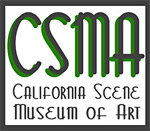In an earlier era of American history, women painters found themselves at home in an aesthetically progressive niche within California Scene Painting. From 1930 to 1960, California artists flocked to vantage points across the Golden State to capture its unique landscape and developing city scenes. Women artists in particular upheld a modern perspective in the movement. Painters such as Mary Blair, Alexandra Bradshaw, Vanessa Helder, Ruth Orlieb, Julie Raymond Poulosky, Luvena Vysekal, Dorothy Sklar, among others, were embraced by their male counterparts, and worked alongside them in art schools such as the Chouinard Art Institute in Los Angeles. Although women painters were freely accepted for their talents, they were not expected to seek out same commissions that men coveted at the time, and this difference in objectives allowed them a wider scope on the canvas. They activated domestic spaces with bustling scenes of work and play and captured intimate moments in familial and social life. They also explored new techniques in landscape and city scenes, and in doing so simultaneously pushed creative boundaries while they imbued their art work with a reverence for everyday realities.
In the first half of the 20th Century, most women chose to be guardians of family and household, and fulfilling this role naturally freed them from certain restrictions of the art market. As wives and mothers, women painters could often leave the commissions and coveted mural projects to the men. Many women California Scene Painters were married to successful artists and were elected to other positions of power within the movement and remained active in the artistic community while raising their families. In this way, they painted for more themselves, and broad strokes of creative freedom became evident in their work. In examining the unorthodox angles and compositions in their artworks, it would seem that these women were expressing an individualistic vision of space and time. By documenting snapshots of daily life, they offered the viewer an inside look into behind the scenes moments of their personal lives. Although they may not be recognized as the movement's trailblazers, these adventurous painters succeeded in expanding the stylistic boundaries within the California Scene movement.
The visions of these artists compressed urban and rural scenery to create fantastical, dream-like landscapes where their independent artistic voices could roam free. The point of view of these talented women shifted the focus of California Scene Painting onto to the full experience of their communities, from scenes at the market, to school children at play, to the commotion behind the curtain at the circus. During the 1930s, 40s, and 50s, these painters immortalized genre scenes and added a true "for the people's" perspective to a strong artistic circle. They depicted their world, as they saw it, and transformed the inner workings of the California household into paintings of the California Scene Movement.
